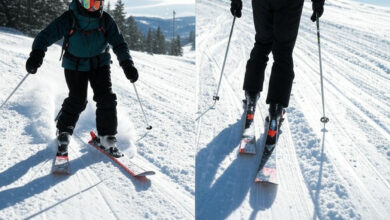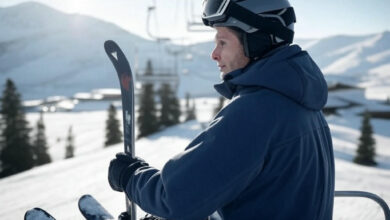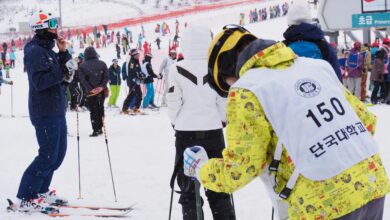How Can We Prevent Knee Injuries While Skiing?

Knee injuries are a common concern among skiers, leading many to wonder: is skiing bad for your knee? The truth is, while skiing offers incredible thrills and breathtaking views, the repetitive motions, variable terrain, and potential for high-impact falls can indeed place significant stress on your knee joints. This raises further questions like is skiing hard on your knee? and is skiing bad for knee?
Understanding the risks is the first step towards prevention. In this comprehensive guide, we’ll delve into the biomechanics of skiing, identifying the factors that contribute to knee injuries. Whether you’re concerned about the long-term effects of the sport ( skiing bad for knee) or simply want to enjoy a season free from pain, we’ll explore actionable strategies, from pre-season conditioning and proper equipment selection to smart on-mountain choices, to help you stay safe, injury-free, and enjoying the slopes all winter long.
Knee injuries in skiing happen when your body and knee twist in opposing directions. This misalignment often stems from improper turning or sudden snow condition changes. These factors can cause a forceful, damaging twist to the knee.
Contents
- 1 Common Knee Injuries
- 1.1 1. Fractures: Bone Breaks on the Slopes
- 1.2 2. ACL Injury: Tearing a Crucial Ligament
- 1.3 3. MCL Injury: Medial Side Strain
- 1.4 4. Meniscal Tears: Cartilage Cushion Damage
- 1.5 5. Patellofemoral Pain Syndrome (PFPS): Skier’s Knee
- 1.6 6. Tendonitis/Tendinosis: Overuse and Inflammation
- 1.7 How to Identify a Knee Injury?
- 2 How to Avoid Knee Injuries while Skiing
- 2.0.1 #1: Ski Within Your Limits: Know Your Abilities
- 2.0.2 #2: Know the Conditions: Be Aware of Your Surroundings
- 2.0.3 #3: Listen to Your Body: Don’t Push Through Pain
- 2.0.4 #4: Fall Properly: Practice Safe Falling Techniques
- 2.0.5 #5: Pre-Season Exercise: Prepare Your Muscles
- 2.0.6 #6: Stretch Regularly: Maintain Flexibility
- 2.0.7 #7: Avoid Alcohol: Stay Alert and Coordinated
- 2.0.8 #8: Use Safe Gear: Ensure Proper Equipment Fit
- 2.0.9 #9: Warm-Up Before Hitting the Slopes: Prepare Your Body for Action
- 2.0.10 #10: Consider Using Knee Braces: Added Support and Stability (If Needed)
- 2.1 What to do if you Injure your Knee?
- 3 How Are Knee Injuries Treated?
Common Knee Injuries
Skiing, while exhilarating, places significant demands on the knee joint. The dynamic movements, changing terrain, and potential for falls can lead to various knee injuries. Understanding these injuries is crucial for prevention and proper treatment. The concern is skiing bad for your knee? often stems from the potential for these types of trauma. While knee injuries are common in skiing, the extent of the damage can differ. Here’s a breakdown of some of the most frequently encountered knee problems among skiers:
1. Fractures: Bone Breaks on the Slopes
While soft tissue injuries are more common, fractures, or broken bones, can occur in the knee region during a ski accident, especially from high-speed collisions or awkward landings after jumps. These fractures can involve the femur (thigh bone), tibia (shin bone), fibula (lower leg bone), or patella (kneecap). The severity of the fracture varies; it can range from a hairline crack to a complete break with displacement. Symptoms include immediate and intense pain, swelling, deformity (if the bone is displaced), and an inability to bear weight. Diagnosis requires X-rays, and treatment typically involves immobilization with a cast or splint, and in some cases, surgery to realign the bone fragments. When people ask is skiing hard on your knee? the potential for fractures from falls are a valid cause of concern.
2. ACL Injury: Tearing a Crucial Ligament
The Anterior Cruciate Ligament (ACL) is a vital ligament in the knee that prevents the tibia from sliding forward on the femur. ACL tears are among the most common and debilitating knee injuries in skiing. They often occur when the skier experiences a sudden twisting motion, a direct blow to the knee, or a hyperextension (bending backward) of the knee. You often hear people ask is skiing bad for knee? with this specific injury in mind. A classic mechanism involves catching an edge, leaning back, and the ski acting as a lever to force the tibia forward. Symptoms include a popping sensation at the time of injury, immediate and severe pain, rapid swelling, instability (a feeling that the knee is giving way), and limited range of motion. Diagnosis is usually confirmed with an MRI. Treatment options range from conservative management (physical therapy and bracing) for less severe tears to surgical reconstruction of the ACL for more significant instability, especially in active individuals.
3. MCL Injury: Medial Side Strain
The Medial Collateral Ligament (MCL) is located on the inner side of the knee and provides stability against sideways forces. MCL injuries typically result from a direct blow to the outside of the knee, forcing it inward (valgus stress). This can happen during a fall where the ski catches an edge, or from a collision. Symptoms include pain and tenderness along the inner side of the knee, swelling, stiffness, and instability. The severity of MCL injuries is graded from I (mild sprain) to III (complete tear). Treatment usually involves conservative management, including rest, ice, compression, elevation (RICE), bracing, and physical therapy to regain strength and range of motion. Surgery is rarely needed for isolated MCL tears.
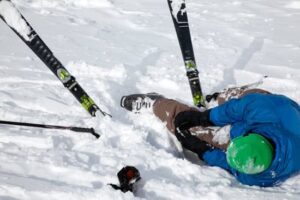
4. Meniscal Tears: Cartilage Cushion Damage
The menisci are C-shaped pieces of cartilage that act as shock absorbers within the knee joint. Skiing involves repetitive bending, twisting, and weight-bearing, which can put stress on the menisci, leading to tears. These tears can occur due to acute trauma (a sudden twist) or from chronic overuse. Symptoms include pain (often localized to a specific area of the knee), clicking or popping sensations, swelling, stiffness, and a feeling of locking or catching in the knee. Diagnosis is often confirmed with an MRI. Treatment options include conservative management (physical therapy) for smaller tears, or arthroscopic surgery to repair or remove the damaged portion of the meniscus for more significant tears causing persistent symptoms.
5. Patellofemoral Pain Syndrome (PFPS): Skier’s Knee
PFPS, also known as “skier’s knee,” is a common condition characterized by pain around the kneecap (patella). It’s often caused by overuse, muscle imbalances, or improper knee alignment, all of which can be exacerbated by the demands of skiing. The pain is often described as a dull ache that worsens with activities like squatting, kneeling, or going down stairs. Symptoms can also include clicking or grinding sensations. Treatment focuses on addressing the underlying causes through physical therapy, which may include strengthening exercises for the quadriceps, hamstrings, and hip muscles, as well as stretching exercises to improve flexibility. Proper ski technique and equipment adjustments can also help alleviate the stress on the patellofemoral joint.
6. Tendonitis/Tendinosis: Overuse and Inflammation
The tendons around the knee, such as the patellar tendon (connecting the kneecap to the shin bone) and the quadriceps tendon (connecting the quadriceps muscles to the kneecap), can become inflamed or degenerated due to repetitive stress and overuse during skiing. This can lead to tendonitis (inflammation) or tendinosis (chronic degeneration). Symptoms include pain and tenderness along the affected tendon, which worsens with activity. Treatment involves rest, ice, compression, elevation (RICE), pain relievers, and physical therapy to strengthen the surrounding muscles and improve flexibility. In some cases, a brace may be recommended to support the knee.
By understanding these common knee injuries and their causes, skiers can take proactive steps to minimize their risk and enjoy a safer and more enjoyable experience on the slopes. The concerns regarding whether skiing bad for knee can be addressed through preventative measures and proper training.
How to Identify a Knee Injury?
Promptly identifying a knee injury is crucial for initiating appropriate treatment and preventing further damage. While the specific symptoms vary depending on the type and severity of the injury, there are some common signs that should raise suspicion:
-
Sudden, Sharp Pain: A sudden, intense pain at the time of the injury is a red flag, particularly if it’s accompanied by a popping or snapping sensation. This is frequently associated with ligament tears like ACL or MCL injuries. However, pain can also develop gradually with overuse injuries.
-
Popping or Snapping Sound/Sensation: A distinct “pop” or “snap” heard or felt at the moment of the injury is often indicative of a ligament tear (especially the ACL). This sound occurs as the ligament fibers rupture. A less dramatic popping or clicking feeling can sometimes point to meniscal damage.
-
Swelling: Swelling is a common response to knee injuries. Rapid swelling (within a few hours) often suggests bleeding inside the joint, which can occur with ligament tears or fractures. Slower-developing swelling might indicate a less severe sprain or overuse injury.
-
Instability or Giving Way: A feeling that the knee is “giving way” or buckling, especially when weight-bearing, is a strong indicator of ligament damage, particularly an ACL tear. This instability means the knee is unable to properly support your weight.
-
Limited Range of Motion: Difficulty bending or straightening the knee, or a feeling of stiffness or locking, can signal a variety of knee problems, including ligament sprains, meniscal tears, or swelling within the joint.
-
Tenderness to the Touch: Pain when you press on specific areas of the knee can help pinpoint the location of the injury. For example, tenderness along the inner side of the knee suggests an MCL injury, while tenderness along the joint line might indicate a meniscal tear.
-
Bruising: Bruising around the knee can indicate bleeding from damaged blood vessels, which often accompanies more severe injuries like fractures or ligament tears.
-
Difficulty Weight-Bearing: Inability to put weight on the injured leg, or significant pain when doing so, indicates a more severe injury. This requires immediate assessment to rule out fractures or significant ligament tears.
Important Considerations:
-
Severity Matters: The intensity of these symptoms often correlates with the severity of the injury. A mild sprain may cause only mild pain and swelling, while a complete ligament tear can cause excruciating pain and complete instability.
-
Listen to Your Body: Don’t try to “tough it out” if you suspect a knee injury. Continuing to ski on an injured knee can worsen the damage.
-
Seek Professional Evaluation: If you experience any of these symptoms, it’s crucial to seek a professional medical evaluation from a doctor or physical therapist. They can perform a thorough examination, order imaging tests (like X-rays or MRI), and provide an accurate diagnosis and treatment plan.
Prompt identification of a knee injury allows for timely intervention, which is vital for optimal healing and a return to skiing (and other activities) as quickly and safely as possible.
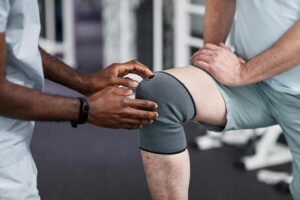
How to Avoid Knee Injuries while Skiing
The question, is skiing bad for your knee?, is a valid one. While skiing is an incredible sport, it does place stress on the knees. However, with the right preparation and precautions, you can significantly reduce your risk of injury and enjoy a long and healthy skiing career. Is skiing hard on your knee? It can be, but it doesn’t have to be! Here’s how to minimize the risk and keep those knees happy:
#1: Ski Within Your Limits: Know Your Abilities
One of the biggest contributors to knee injuries is overconfidence. Is skiing bad for knee? It certainly becomes more dangerous when you’re tackling terrain that exceeds your skill level. Be honest with yourself about your abilities and stick to slopes that are appropriate for your experience. Trying to keep up with more advanced skiers can lead to risky maneuvers and increased chances of a fall that could damage your knees.
Start with easier slopes and gradually progress to more challenging terrain as your skills and confidence improve. Don’t be afraid to take a lesson from a qualified instructor to refine your technique and learn how to handle different types of snow and terrain safely. Remember, it’s much better to be slightly bored on an easy run than to be lying injured at the bottom of a black diamond.
#2: Know the Conditions: Be Aware of Your Surroundings
Snow conditions can change dramatically throughout the day, and these changes can significantly impact your risk of injury. Icy patches, deep powder, crud (heavy, uneven snow), and moguls all require different skiing techniques and can put varying degrees of stress on your knees.
Before heading out, check the weather forecast and snow report. Pay attention to any warnings about icy conditions or avalanche danger. While on the slopes, be observant of changing snow conditions and adjust your skiing accordingly. Slow down and take extra precautions when navigating unfamiliar or challenging terrain.
#3: Listen to Your Body: Don’t Push Through Pain
Ignoring pain is a recipe for disaster. If you experience any discomfort or pain in your knees while skiing, stop immediately. Continuing to ski through pain can worsen an existing injury and lead to more serious problems.
Take breaks throughout the day to rest and recover. If you’re feeling tired or sore, don’t hesitate to call it quits early. It’s better to miss a few runs than to risk a season-ending injury. Pay attention to signals from your body. Rest and hydrate accordingly.
#4: Fall Properly: Practice Safe Falling Techniques
Falling is inevitable in skiing, but knowing how to fall properly can significantly reduce your risk of injury. The key is to try to relax your body and avoid extending your arms or legs to brace yourself.
Instead, try to fall to the side and let your skis release. Keep your knees bent and your arms close to your body. Avoid twisting or turning your body in unnatural ways. Learning how to fall safely can make the difference between a minor tumble and a serious injury.
#5: Pre-Season Exercise: Prepare Your Muscles
Strengthening the muscles around your knees is crucial for providing support and stability to the joint. A pre-season exercise program should focus on strengthening your quadriceps, hamstrings, glutes, and core muscles.
Exercises like squats, lunges, hamstring curls, and planks are all excellent for preparing your body for the demands of skiing. Start your pre-season training several weeks before your first ski trip to allow your muscles time to adapt and strengthen. This will help you answer the question of “is skiing hard on your knee?” with a confident, “Not for me!”.
Best Strength Exercises Must Consider:
- Squats
- Squat jumps
- Wall squats
- Lunges
- Side planks
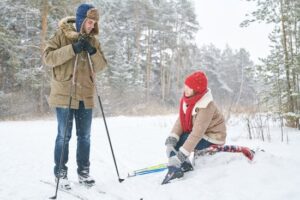
#6: Stretch Regularly: Maintain Flexibility
Flexibility is just as important as strength for preventing knee injuries. Tight muscles can restrict your range of motion and increase your risk of strains and sprains.
Incorporate regular stretching into your pre-season and on-mountain routine. Focus on stretching your quadriceps, hamstrings, hip flexors, and calf muscles. Hold each stretch for 20-30 seconds and repeat several times. Stretching helps improve your mobility and reduces muscle imbalances.
Perfect Stretches to Do Before You Ski / Snowboard:
- Transverse Oblique Twist
- Straight Leg Hang
- 3-Way Hamstring / Back Reaches
- Deep Glute Pull
- Hip Flexor / Quadriceps
- Chest Stretch
#7: Avoid Alcohol: Stay Alert and Coordinated
Alcohol impairs your judgment, balance, and coordination, all of which are essential for safe skiing. Skiing under the influence significantly increases your risk of falls and injuries.
Avoid consuming alcohol before or during skiing. Save the après-ski drinks for after you’ve finished your last run of the day. Staying sober ensures you’re alert and able to react quickly to changing conditions on the slopes.
#8: Use Safe Gear: Ensure Proper Equipment Fit
Properly fitted ski boots, bindings, and skis are essential for safety. Make sure your boots are comfortable and provide adequate support for your ankles and knees. Have your bindings professionally adjusted by a qualified ski technician to ensure they release properly in the event of a fall.
Rent or purchase skis that are appropriate for your skill level and the type of terrain you’ll be skiing on. Regularly inspect your equipment for any signs of wear and tear and have it serviced as needed.
#9: Warm-Up Before Hitting the Slopes: Prepare Your Body for Action
Jumping straight onto the slopes without warming up is like starting a car on a cold morning without letting the engine idle. Your muscles and joints need to be gradually prepared for the exertion of skiing.
Before your first run, perform a light warm-up routine that includes dynamic stretches like arm circles, leg swings, and torso twists. A few minutes of light cardio, such as jogging in place or jumping jacks, can also help increase blood flow to your muscles.
#10: Consider Using Knee Braces: Added Support and Stability (If Needed)
While not necessary for every skier, knee braces can provide added support and stability to the knee joint, especially for individuals with a history of knee injuries or those who are concerned about their risk.
There are different types of knee braces available, ranging from simple sleeves that provide compression to more complex hinged braces that offer greater stability. Talk to your doctor or a physical therapist to determine if a knee brace is right for you and which type would be most beneficial. Knee braces are something to consider to help answer skiing bad for knee?.
What to do if you Injure your Knee?
Injuring your knee on the slopes can be frightening, but knowing how to respond can minimize further damage and facilitate a smoother recovery. Here’s a clear course of action:
1. Stop Skiing Immediately:
The first and most important step is to stop skiing as soon as you suspect a knee injury. Continuing to ski, even if you think it’s “not that bad,” can significantly worsen the injury and prolong your recovery.
2. Assess the Situation (If Possible):
If you’re able, take a moment to assess the severity of the injury. Can you put any weight on the leg without excruciating pain? Are you experiencing significant swelling or instability? If you’re alone, use your cell phone to call ski patrol if you need assistance. If you’re with others, let them know you’ve injured your knee.
3. Signal for Help (If Needed):
If you’re unable to move or the pain is severe, signal for help. Wave your arms, use a whistle (if you have one), or call ski patrol on your cell phone. Ensure your location is clear to rescuers.
4. Stay Warm and Comfortable:
While waiting for help, try to stay warm and comfortable. Use extra layers of clothing to insulate yourself from the cold. If possible, elevate your injured leg to reduce swelling.
5. Get Transported Safely to a Medical Facility:
Allow ski patrol or other trained personnel to transport you to a medical facility. They have the expertise and equipment to move you safely without exacerbating your injury. Don’t try to ski down the mountain on an injured knee!
6. Seek Medical Evaluation and Diagnosis:
At the medical facility (ski area clinic or hospital), a doctor will evaluate your knee and perform a physical examination. They may order X-rays to rule out fractures and an MRI to assess the extent of ligament or cartilage damage. An accurate diagnosis is crucial for developing an appropriate treatment plan.
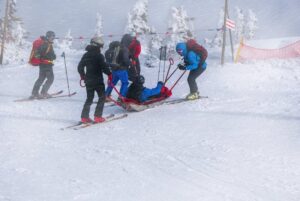
7. Follow the RICE Protocol (Initially):
Regardless of the severity of the injury, the RICE protocol is often recommended in the initial stages:
-
Rest: Avoid any activities that put stress on your knee.
-
Ice: Apply ice packs to the injured area for 15-20 minutes at a time, several times a day.
-
Compression: Use a compression bandage to help reduce swelling.
-
Elevation: Elevate your injured leg above your heart to further reduce swelling.
8. Follow the Doctor’s Treatment Plan:
The doctor will develop a treatment plan based on the type and severity of your knee injury. This may include:
-
Pain medication: To manage pain and inflammation.
-
Bracing: To provide support and stability to the knee.
-
Physical therapy: To regain strength, range of motion, and stability.
-
Surgery: In some cases, surgery may be necessary to repair torn ligaments or cartilage.
9. Commit to Rehabilitation:
Rehabilitation is essential for a full recovery from a knee injury. Follow your physical therapist’s instructions carefully and perform the prescribed exercises regularly. Don’t rush the process; it’s better to take your time and fully recover than to return to skiing too soon and risk re-injury.
10. Gradually Return to Skiing (When Approved by Your Doctor):
Don’t return to skiing until your doctor and physical therapist have cleared you to do so. When you do return, start slowly and gradually increase the intensity and duration of your skiing. Pay attention to your body and stop immediately if you experience any pain or discomfort.
Remember, patience and diligence are key to a successful recovery from a knee injury. By following these steps, you can minimize the long-term effects of the injury and increase your chances of returning to the slopes stronger and more confident than before.
How Are Knee Injuries Treated?
Treatment for knee injuries is highly individualized, depending on the type, severity, and location of the injury, as well as the patient’s age, activity level, and overall health. The primary goals of treatment are to reduce pain and swelling, restore range of motion, strengthen the muscles around the knee, and return the patient to their desired activity level. Treatment approaches generally fall into two categories: conservative (non-surgical) and surgical.
I. Conservative (Non-Surgical) Treatment:
Conservative treatment is often the first line of defense for less severe knee injuries, such as mild sprains, strains, and some meniscal tears. The aim is to allow the body to heal itself naturally, supported by various therapies.
-
RICE Protocol: As mentioned previously, the RICE protocol (Rest, Ice, Compression, Elevation) is a cornerstone of initial management.
-
Rest: Avoiding activities that aggravate the injury.
-
Ice: Applying ice packs for 15-20 minutes at a time, several times a day, to reduce pain and swelling.
-
Compression: Using a compression bandage to provide support and minimize swelling.
-
Elevation: Elevating the injured leg above the heart to further reduce swelling.
-
-
Pain Management: Over-the-counter pain relievers, such as ibuprofen (Advil, Motrin) or naproxen (Aleve), can help manage pain and inflammation. In some cases, a doctor may prescribe stronger pain medications.
-
Bracing: Knee braces can provide support and stability to the knee, protecting it from further injury and allowing it to heal. Different types of braces are available, ranging from simple sleeves to hinged braces that limit motion.
-
Physical Therapy: Physical therapy is crucial for regaining strength, range of motion, and stability in the knee. A physical therapist will develop a personalized exercise program that may include:
-
Range-of-motion exercises: To improve flexibility and reduce stiffness.
-
Strengthening exercises: To strengthen the muscles around the knee, such as the quadriceps, hamstrings, and calf muscles.
-
Balance and proprioception exercises: To improve balance and coordination.
-
Functional exercises: To prepare the knee for return to activity.
-
-
Injections: In some cases, a doctor may inject corticosteroids or hyaluronic acid into the knee joint to reduce pain and inflammation. Corticosteroids provide short-term pain relief but can have potential side effects with repeated use. Hyaluronic acid is a lubricant that can help improve joint mobility.
II. Surgical Treatment:
Surgery may be necessary for more severe knee injuries, such as complete ligament tears, displaced fractures, or significant cartilage damage that doesn’t respond to conservative treatment.
-
Arthroscopy: Many knee surgeries are performed arthroscopically, which involves inserting a small camera and surgical instruments through tiny incisions. Arthroscopy allows surgeons to visualize and repair damage inside the knee with minimal tissue disruption.
-
Meniscal repair or removal: Torn meniscus cartilage can be repaired (sutured) or, if repair isn’t possible, the damaged portion can be removed (meniscectomy).
-
ACL reconstruction: A torn ACL is typically reconstructed using a graft of tissue from another part of the body (such as the hamstring tendon, patellar tendon, or quadriceps tendon) or from a deceased donor (allograft).
-
MCL repair or reconstruction: MCL tears are often treated conservatively, but surgery may be necessary in severe cases or when other ligaments are also injured.
-
Cartilage repair or regeneration: Various techniques can be used to repair or regenerate damaged cartilage, such as microfracture, osteochondral autograft transplantation (OATS), or autologous chondrocyte implantation (ACI).
-
-
Open Surgery: In some cases, open surgery (involving a larger incision) may be necessary to address complex knee injuries, such as displaced fractures or severe ligament damage.
III. Post-Surgical Rehabilitation:
Regardless of the type of surgery performed, post-surgical rehabilitation is crucial for a successful outcome. Rehabilitation protocols vary depending on the specific procedure, but they typically involve:
-
Pain and swelling management: Using ice, compression, and elevation to reduce pain and swelling.
-
Range-of-motion exercises: Gradually increasing the range of motion in the knee.
-
Strengthening exercises: Strengthening the muscles around the knee.
-
Balance and proprioception exercises: Improving balance and coordination.
-
Functional exercises: Preparing the knee for return to activity.
The recovery process can take several months, and it’s important to follow the rehabilitation protocol closely to maximize the chances of a full recovery.
Key Considerations:
-
Individualized Treatment: As emphasized, treatment is always tailored to the individual patient and the specific injury.
-
Importance of Early Intervention: Seeking medical attention promptly after a knee injury is crucial for accurate diagnosis and timely treatment.
-
Commitment to Rehabilitation: A dedicated commitment to rehabilitation is essential for a successful outcome, regardless of whether conservative or surgical treatment is chosen.
By understanding the available treatment options and working closely with a medical professional, individuals with knee injuries can optimize their chances of a full recovery and a return to their desired activities.
Is Skiing Dangerous?
The question of whether skiing is dangerous is complex. On the one hand, it’s an exhilarating outdoor activity that offers numerous physical and mental health benefits. On the other hand, it involves speed, variable terrain, and the potential for falls, all of which can lead to injuries. So, the answer is nuanced: skiing carries inherent risks, but the level of danger depends on several factors.
Understanding the Risks:
-
Speed and Terrain: Skiing involves traveling at relatively high speeds down varied terrain. This combination increases the risk of falls and collisions. Unpredictable snow conditions, such as ice or deep powder, can further contribute to instability.
-
Physical Exertion: Skiing is physically demanding, requiring strength, endurance, and balance. Fatigue can increase the likelihood of mistakes and injuries.
-
Weather Conditions: Inclement weather, such as poor visibility, strong winds, and extreme cold, can make skiing more challenging and dangerous.
-
Other Skiers and Obstacles: Collisions with other skiers or obstacles (trees, rocks, etc.) are a common cause of injuries.
-
Knee Injuries: As we’ve discussed, the knee joint is particularly vulnerable to injury in skiing due to the twisting motions and forces involved.
-
Head Injuries: While less common than knee injuries, head injuries can be serious and potentially life-threatening.
Factors That Influence the Level of Danger:
-
Skill Level: Beginner skiers are generally at a higher risk of injury than experienced skiers because they are still developing their skills and techniques.
-
Terrain Choice: Skiing on terrain that is beyond your skill level significantly increases the risk of falls and injuries.
-
Snow Conditions: Icy or deep powder conditions can be more challenging and dangerous than groomed slopes.
-
Equipment: Properly fitted and well-maintained equipment is essential for safety.
-
Personal Responsibility: Skiing responsibly, adhering to the Skier’s Responsibility Code, and being aware of your surroundings can significantly reduce your risk of injury.
-
Alcohol and Drug Use: Skiing under the influence of alcohol or drugs impairs judgment and coordination, increasing the risk of accidents.
Mitigating the Risks: How to Ski Safely:
Despite the inherent risks, there are many things you can do to minimize the danger and enjoy a safe skiing experience:
-
Take Lessons: Invest in lessons from a qualified instructor to learn proper technique and improve your skills.
-
Ski Within Your Limits: Choose terrain that is appropriate for your skill level and avoid taking unnecessary risks.
-
Be Aware of Your Surroundings: Pay attention to other skiers, obstacles, and changing snow conditions.
-
Use Appropriate Equipment: Ensure your ski boots, bindings, and skis are properly fitted and maintained.
-
Wear a Helmet: Helmets are essential for protecting your head in the event of a fall.
-
Warm-Up Before Skiing: Prepare your muscles and joints for the exertion of skiing with a proper warm-up routine.
-
Take Breaks: Rest and hydrate regularly to avoid fatigue.
-
Avoid Alcohol and Drugs: Never ski under the influence of alcohol or drugs.
-
Follow the Skier’s Responsibility Code: Adhere to the rules of the mountain to ensure your safety and the safety of others.
The Bottom Line:
Skiing is not without its risks, but it doesn’t have to be inherently dangerous. By understanding the potential hazards, taking appropriate precautions, and skiing responsibly, you can significantly reduce your risk of injury and enjoy the many rewards that skiing has to offer. Ultimately, the level of danger is largely within your control. Like any sport with speed and variable conditions, common sense and preparation are key.
Conclusion:
Skiing offers an unparalleled blend of exhilarating adventure, breathtaking scenery, and invigorating exercise. However, like any sport that pushes the boundaries of physical exertion in dynamic environments, it’s crucial to acknowledge and address the inherent risks. As we’ve explored, concerns surrounding “is skiing bad for your knee?” and related questions are valid, given the potential for knee injuries and other accidents on the slopes.
Fortunately, knowledge is power. By understanding the common causes of knee injuries, recognizing early warning signs, and diligently implementing preventive measures, you can significantly reduce your risk and enhance your overall skiing experience. From pre-season conditioning and proper equipment selection to responsible on-mountain choices and skillful falling techniques, every step you take contributes to a safer and more enjoyable time on the snow.
The key takeaway is this: skiing doesn’t have to be excessively dangerous. By prioritizing preparation, respecting your limits, and maintaining a mindful awareness of your surroundings, you can minimize the risks and maximize the rewards. So, gear up, hit the slopes with confidence, and remember to prioritize safety above all else. With the right approach, you can enjoy a lifetime of fulfilling skiing adventures while protecting your knees and staying healthy on the mountain.


